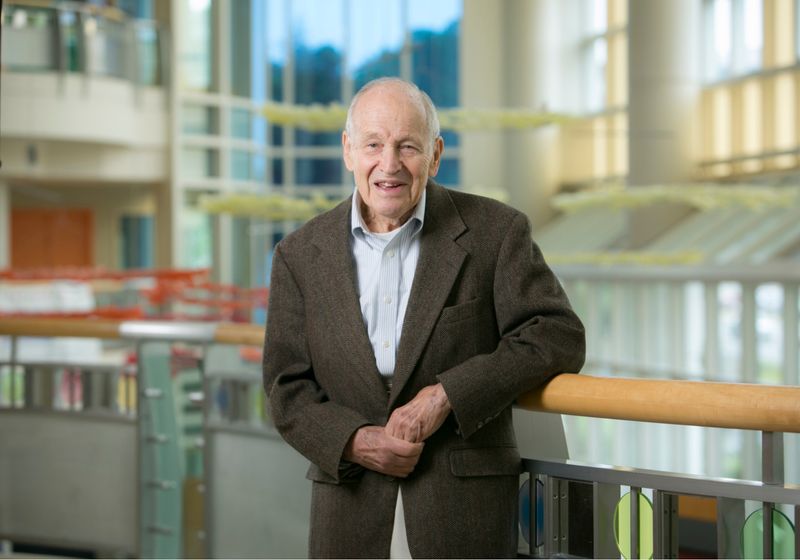Measles was once a common childhood ailment, claiming millions of lives globally each year. Samuel Katz, one of the primary developers of the attenuated measles vaccine that helped to slash that death toll, died at his home in Chapel Hill, North Carolina, on October 31 at age 95.
Katz was born in New Hampshire on May 29, 1927. According to an obituary from Duke University, he completed a year at Dartmouth College before enlisting in the United States Navy in 1945. Since World War II was nearing its end, he was sent to work in a San Diego hospital. His interest in medicine was piqued, and when he returned to Dartmouth, he completed his undergraduate degree and then a two-year preclinical program in 1950. He attended medical school at Harvard University, graduating in 1952. Katz then stayed in Boston, doing training and fellowships at hospitals around the city.
According to a 2009 alumni profile from Dartmouth, Katz was in the third year of his residency in 1955 when a scourge of polio hit the Boston area. A vaccine against the disease had recently been approved by the US Food and Drug Administration (FDA) but hadn’t yet been widely distributed. Katz and other doctors worked around the clock to see the line of sick children and worried parents outside, using flashlights after the sun went down. This experience prompted him to pursue a career in pediatric infectious diseases.
See “Jean Macnamara’s Multiple Causes, 1931”
The previous year, Boston-based virologist John Enders received the Nobel Prize in Physiology or Medicine for isolating the polio virus. The Washington Post reports that Katz contacted him as the polio outbreak abated about joining Enders’s lab at Boston Children’s Hospital to work on developing a measles vaccine.
Katz and others infected a series of chicks with the measles virus to successfully attenuate it. Because the virus doesn’t replicate well in chickens, it became weaker each time it infected a new host until the virus induced an immune response without symptoms or active viral infection. By the late 1950s, human trials began, and the vaccine successfully elicited antibodies in the blood of patients without signs of infection by the virus itself. In 1960, Enders, Katz, and their colleagues published their results, which were met with tremendous interest.
See “Bile and Potatoes, 1921”
That same year, Katz began work trialing the new vaccine in Nigeria, where the mortality rate for measles was much higher than in the US. The vaccine was given to hundreds of children, and the success of the trial helped get the vaccine licensed. According to the World Health Organization, the vaccine was described as 100 percent effective, and the FDA approved the vaccine in 1963. In 1968, the vaccine Katz worked on was replaced by an even weaker form of the virus that had milder side effects.
The same year, he became the head of pediatrics at the Duke University School of Medicine, a position he held for 22 years. There, Katz developed immunizations for polio, rubella, influenza, and many other viral diseases. In 1990, he stepped down from this administrative role to focus on pediatric AIDS alongside his second wife, immunologist Catherine Wilfert.
In addition to his official duties at Duke, Katz spent much of his time advocating for pediatric immunizations both globally and in the US. According to a newsletter from the Pediatric Infectious Diseases Society, Katz joined the organization soon after it was founded in 1977. The following year, at the inaugural meeting, he co-led a program promoting the measles vaccine. He was an advisor to the Centers for Disease Control and Prevention on immunizations from 1982 to 1993.
According to the Post, Katz testified before Congress in 1999 on behalf of the American Academy of Pediatrics and the Infectious Disease Society of America, reminding lawmakers what the world was like before childhood vaccinations were commonplace as the Committee on Government Reform debated regulations around mandatory vaccinations versus personal choice.
“Most young parents cannot appreciate, fortunately, as I do, the horror of polio with iron lungs and crutches; measles with encephalitis; meningitis due to haemophilus influenza B . . . the deafness, blindness and brain injury . . . caused by congenital rubella; tetanus of newborn infants with overwhelming mortality; and a number of the other infectious diseases that we fortunately do not see,” he said.
Katz was preceded in death by a son, Samuel, in 1980 and his wife, Catherine Wilfert, in 2020. He is survived by six children, two stepchildren, and 17 grandchildren.














